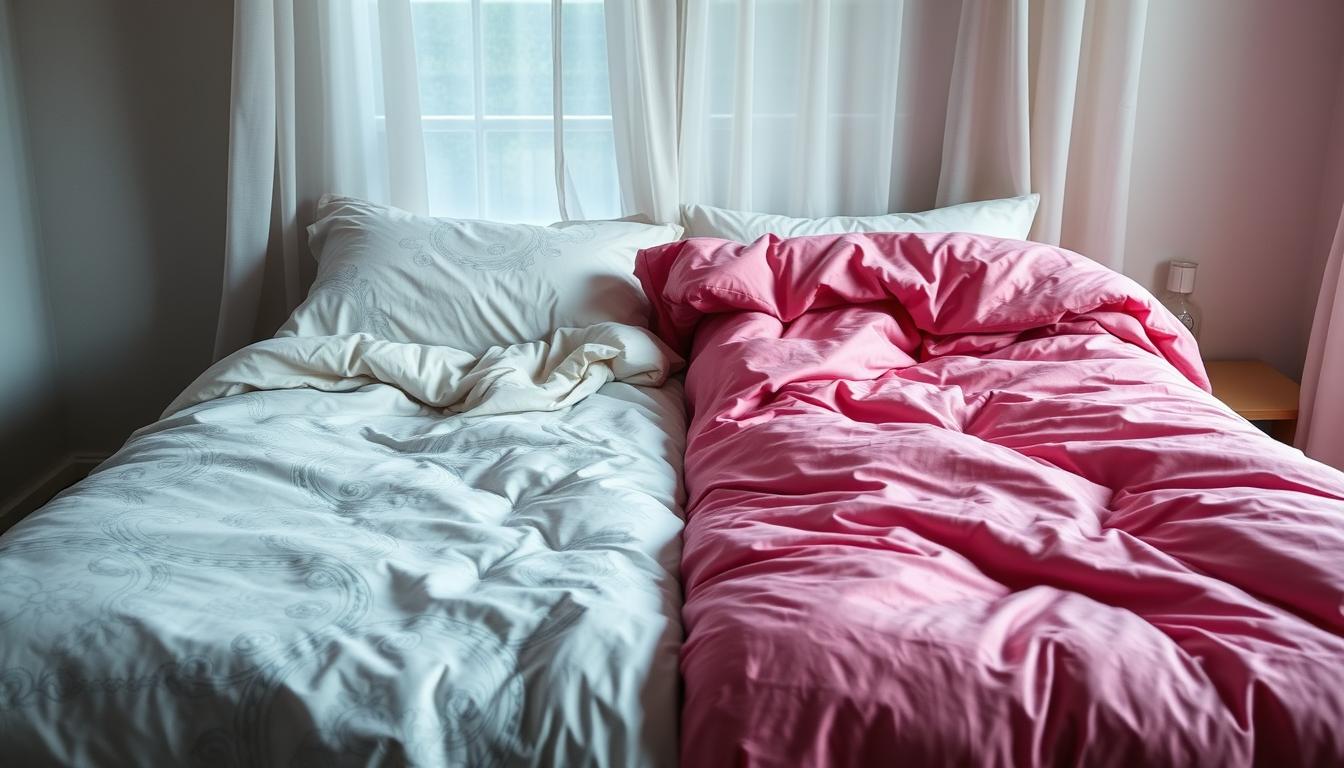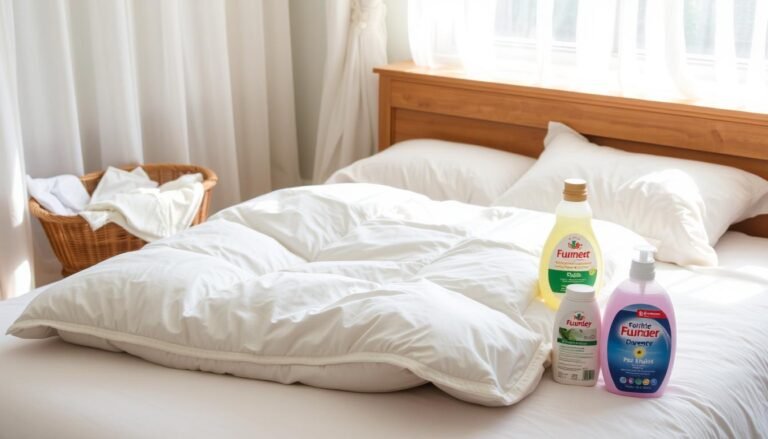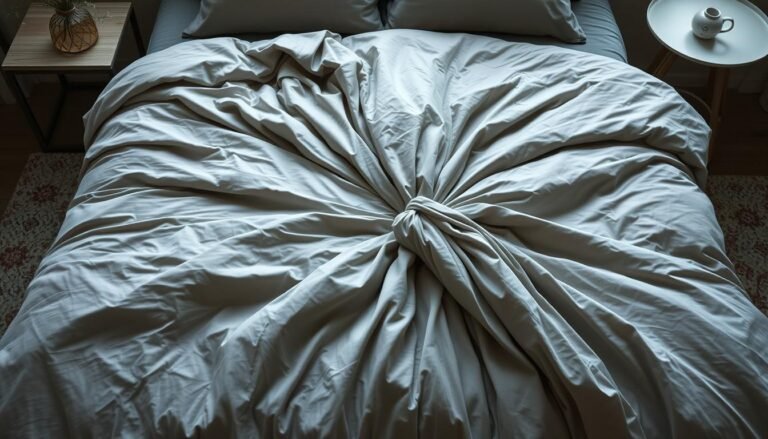Duvet Cover vs Comforter: Key Differences Explained
Understanding the difference between a duvet cover and comforter is key for a cozy bedroom. A duvet cover is a protective layer for a duvet insert. This insert might be filled with down, feathers, or synthetic fibers. The cover comes in materials like cotton or polyester, letting you change your bed’s look by switching covers. On the other hand, a comforter is a quilted bed topper, usually filled with synthetic fibers. It does not need a separate cover.
Cleaning ease is a big point in the duvet vs comforter discussion. Surveys show people find duvet covers easier to clean. They can just take them off and wash them in a machine. Design flexibility is another plus for duvets. They let you change the room’s look without much effort. Duvet covers and comforters meet different needs and tastes in bedding.
Market trends tell us duvets are popular in Europe, while comforters are big in the US. This might be due to duvets’ adaptability to different seasons. This is handy in places with varying weather. Choosing between these bedding types is about what you prefer. It also depends on your lifestyle and your bedroom’s design and comfort.
Choosing a duvet or comforter? Knowing the key differences helps you decide better. It ensures your sleep space meets your needs and preferences perfectly.
What is a Duvet Cover?
Knowing about duvet covers is key for anyone wanting to improve their bedroom while keeping it clean. A duvet cover is a protective layer for your duvet insert. It’s a must-have in your bedding collection.
Definition and Origin
Duvet covers started in Europe and are now loved worldwide. They’re versatile and practical. A duvet cover is a fabric case for your duvet, often with buttons, zippers, or ties. It’s easy to wash, so your bedding stays clean without washing the whole duvet.
Materials and Construction
The materials for duvet covers vary to match your taste and needs. Choices include cotton, linen, flannel, and silk. Each offers different comfort, durability, and style:
- Cotton: Breathable and easy to care for, great for everyday.
- Linen: Cool and crisp, perfect for hot weather.
- Flannel: Warm and cozy, great for cold nights.
- Silk: Smooth and luxurious, for a touch of elegance.
Knowing what a duvet cover is and how it’s made helps pick the right material. Duvet covers have careful stitching and closures like buttons or zippers. This keeps the duvet in its place.
How Duvet Covers Are Used
Duvet covers are very versatile. They protect your duvet from getting dirty and make it last longer. They also let you change your room’s look easily. Just swap the duvet cover to match the season or your style.
A duvet cover usually has an opening at the bottom for the duvet. It’s then closed with buttons or zippers. This keeps the duvet fixed but looks neat. Cleaning them is easier than washing a big duvet.
Duvet covers should be washed every two weeks, says Ruthie Osswald from Brooklinen. It keeps your sleeping space hygienic.
In hotels and hospitality, duvet covers are preferred for their washability and fresh bedding for guests. Whether for a hotel or your home, knowing about duvet covers is vital for a good choice.
| Store | Duvet Price Range | Comforter Price Range |
|---|---|---|
| Amazon | $25 – $85 | $30 – $80 |
| Target | $30 – $160 | $50 – $150 |
| Macy’s | $80 – $350 | $100 – $300 |
| Pottery Barn | $70 – $200 | $150 – $300 |
What is a Comforter?
Have you ever wondered, what is a comforter? Comforters are a favorite in American homes for their convenience and design. They’re a one-piece quilted bed topper that doesn’t need a separate cover. This feature makes them perfect for those who want simple bedding.
Definition and Origin
Comforters started as a need for a warm bed covering. Now, they’re a key part of modern bedding. The word “comforter” means a thick, quilted blanket that keeps you warm. They lay on top of bed sheets and usually don’t need more covers.
Materials and Construction
The making of comforters is detailed. They’re made from various top-notch fabrics and fillings. Most comforters are filled with down or synthetic materials that keep you warm like down but are allergy-friendly. The cover is often cotton, polyester, or a mix of the two. Here are some common materials:
| Material | Description |
|---|---|
| Down | Provides excellent insulation, lightweight but warm, derived from goose or duck feathers. |
| Down Alternative | Hypoallergenic, made from synthetic fibers, and mimics the warmth and fluffiness of down. |
| Cotton | Breathable and soft, often used for the outer fabric. |
| Polyester | Durable, cost-effective, and easy to clean, commonly used in both filling and outer fabric. |
How Comforters Are Used
Comforters are popular because they’re easy to use. They go right on your sheets without needing another cover. This feature is great for those looking for easy bedding. Comforters often come in a set with matching items, making your room look good. They’re also lighter and simpler to clean than heavy duvets.
The difference between duvet cover and comforter
Knowing the difference between duvet cover and comforter helps you choose your bedding wisely. Duvet covers are like protective cases for duvets, easily removed for washing. Comforters, on the other hand, are single pieces that lay on top of the bed and don’t need a cover. This key difference affects cleanliness, the ability to change your room’s look, and the money you spend.
If we look at duvet cover vs comforter, duvet covers stand out for design and cleaning. With duvet covers, you can switch up your bedroom style by changing covers. Plus, they’re easy to clean since you can toss them in the wash.
Comforters score points for being easy to use. They often come in sets with sheets and pillowcases, making your bed look great with less effort. While comforters are cheaper at first, they might cost more to keep clean over time because they’re bulky and may need to be dry cleaned.
Talking about seasons, comforter vs duvet comparison shows differences too. Duvets can be adjusted for warmth by changing the insert’s weight. Comforters, though, might not be enough on cold nights without extra blankets. Some people use a duvet cover on their comforter, getting the best of both worlds.
| Duvet Cover | Comforter | |
|---|---|---|
| Design Flexibility | High (removable cover) | Medium (fixed design) |
| Cleaning | Easy (machine washable) | Potentially Expensive (may need professional cleaning) |
| Initial Cost | Moderate (requires separate insert) | Often low (bundled with sheets) |
| Maintenance | Convenient (frequent washing) | Can be cumbersome (size and bulk) |
| Seasonal Adaptability | High (various weights) | Medium (standard weights) |
| Materials | Organic cotton, various fabrics | cotton, microfiber, etc. |
| Market Segment | Sold individually | Commonly sold in sets |
In conclusion, understanding how duvet covers differ from comforters helps you make a smart choice. It’s about finding the right balance between ease of use, style options, and how much you want to spend.
Advantages of Using a Duvet Cover
Choosing a duvet cover brings many benefits. It boosts both your bedtime comfort and room’s look. They offer the chance to easily switch up styles, ensure simple cleaning methods, and adjust for every season’s need.
Design Flexibility
Duvet cover functionality makes it easy to change your bedroom’s appearance. Just swap the duvet cover to match your style or mood. You don’t have to buy a new duvet. This makes refreshing your bedroom’s look simple and fun.
Ease of Cleaning
Duvet cover advantages include ease of cleaning. Duvet covers can be removed and washed without hassle. Your duvet stays clean and lasts longer. This keeps your bedding in top shape while simplifying your laundry routine.
Seasonal Adaptability
Duvet cover tips point out their usefulness all year. They come in different materials for any season. You can have heavier inserts for the cold, or lighter ones for warmer times. This means you stay comfortable no matter the season, making duvet covers a smart bedding choice.
Advantages of Using a Comforter
In the comforter vs duvet cover guide, comforters shine with their benefits. They’re easy to use, less costly, and great for layering. These perks make them a favorite in many homes.
Ease of Use
The main comforter benefit is ease. Straight from the package, they’re ready. No need for a cover. This is great for anyone wanting a simple bedding option.
Affordability and Accessibility
Comforters often cost less than duvet sets. They come in budget-friendly bedding sets. This makes them easy on your wallet. Their wide availability adds to their popularity.
Ideal for Layering
Comforters excel in making layered bed looks. Unlike duvets, they’re flat, making them perfect for layering with throws and quilts. This lets you customize your bedroom for both style and warmth.
| Aspect | Comforter | Duvet |
|---|---|---|
| Quality of Insulation | Good | Excellent |
| Maintenance | Requires frequent washing | Requires less frequent washing |
| Cost | More affordable | More expensive |
| Ease of Use | High | Medium |
| Customizability | Limited | High |
Pros and Cons of Both Bedding Options
Choosing between a duvet and a comforter means looking at each option closely. A duvet and comforter comparison will show different strengths and weaknesses. These differences can affect your comfort, how much care they need, and your room’s look.
Duvets are usually thicker, heavier, and warmer than comforters. They’re great for cold places needing extra warmth. But, putting a duvet in its cover can be tough. They might also need special cleaning based on their materials and make.
Comforters are often thinner and not as warm, fitting mild climates better. They’re found in many colors and styles, making room decorating easier without extra covers. Yet, comforters may not last as long and can be hard to clean because of their size.
| Aspect | Duvet | Comforter |
|---|---|---|
| Warmth | Thicker and warmer | Thinner and less warm |
| Durability | Depends on quality; potentially long-lasting | Varies; might flatten over time |
| Design Flexibility | High; change covers easily | Moderate; fixed design |
| Maintenance | Cover often machine washable; duvet may need special care | Can be bulky and difficult to wash |
| Cost | Varies; higher for down duvets | Generally more affordable |
Duvet covers offer design flexibility but might increase costs due to separate cover purchases. Comforters, sold in sets, make buying easier. However, this limits style changes.
Care needs are key in duvet and comforter comparison. Duvet covers are usually washable, but duvets themselves can be hard to clean. Comforters, bulky and tough to wash, might need a duvet cover for protection.
Understanding each option’s pros and cons is crucial in deciding. Think about your own needs, where you live, and your taste before choosing. This way, your choice will fit your lifestyle and preferences well.
How to Choose Between a Duvet Cover and Comforter
Choosing between a duvet cover and comforter involves several factors. These considerations will steer you towards the right bedding for you.
Consider Your Lifestyle
Your lifestyle is key in this choice. If you want bedding that’s easy to wash, a duvet cover is best. Duvet covers come off and can be cleaned at home. In contrast, comforters, particularly synthetic ones, might need dry cleaning due to their size.
Duvet covers are also great for those who love changing their bedroom’s look. They can be switched easily to fit your design preference bedding.
Climate and Seasonal Requirements
The climate and seasons affect your choice too. Duvets are warm, perfect for cold places and winter. By changing the cover, you can adjust the warmth they provide.
Comforters are good all year in milder climates. Yet, in cold weather, you might need extra blankets for warmth.
Design Preference and Room Aesthetics
Your design preference bedding and the look of your room matter too. Duvet covers let you easily change your bed’s style. They are available in various patterns, colors, and textures. This suits those who frequently update their bedroom’s look.
Comforters often come in sets with matching sheets and pillowcases. This makes achieving a unified bedroom theme easier.
Care and Maintenance Tips
Taking good care of your bedding ensures that it will last a long time and stay comfy. This part gives you important advice on duvet cover maintenance, comforter cleaning tips, and how to care for your bedding properly.
Cleaning Tips for Duvet Covers
Cleaning your duvet covers regularly is key. Always follow the washing instructions on the care label. Most duvet covers can be washed in the machine. It’s good to wash them once a month.
Use a gentle detergent and cycle to keep the material in good shape. Dry them on a low heat to avoid clumps and wrinkles. Don’t forget to take out the duvet insert before washing the cover.
Cleaning Tips for Comforters
Comforters need a special cleaning approach depending on their fill. Those with synthetic fillings are easy to machine wash. Use a big washing machine on a gentle cycle for these. Down or wool-filled comforters might need to be cleaned by professionals. They keep their fluff and warmth this way. For small stains, try spot cleaning to wash them less often. Unlike duvet covers, comforters only need washing every few months.
Storage Tips
Storing your bedding properly is crucial for its upkeep. Keep your bedding in a dry, cool spot to prevent mold and mildew. Using breathable containers or cotton bags is a smart choice. They protect against dust and pests while letting air move. Make sure comforters are totally dry before you store them to stop moisture buildup.
Fold duvet covers neatly for storage in a drawer or on a shelf. This keeps them in tip-top shape and ready for use.
| Maintenance Task | Duvet Cover | Comforter |
|---|---|---|
| Washing Frequency | Monthly | Every Few Months |
| Washing Method | Machine Wash | Machine Wash or Professional Cleaning |
| Drying Method | Tumble Dry Low | Air Dry or Tumble Dry Low |
| Storage | Cool, Dry Place | Cool, Dry Place |
Cost Comparison: Duvet Covers vs Comforters
Choosing between a duvet and a comforter involves knowing their costs. Consider the initial price, upkeep, and their effect on nature.
Initial Purchase Costs
Duvet covers usually cost less at first than comforters. But, adding a duvet insert, like goose down, can make it pricier. On average, a comforter is about $120. Duvet covers range from $50 to $400, not including the insert.
Long-term Maintenance Costs
Maintaining duvets and comforters comes with different costs. Comforters need washing more, which can cause wear and raise laundry bills. But duvet covers protect the insert, needing less washing. This means duvets might last longer and cost less over time.
Environmental Impact
Duvets are more eco-friendly. Changing covers is better for the environment than buying new comforters. It means less waste and supports a greener lifestyle. Also, replacing inserts instead of the whole comforter reduces harm to nature.
| Feature | Duvet Cover | Comforter |
|---|---|---|
| Initial Purchase Cost | $50 – $400 (insert not included) | $50 – $400 |
| Long-term Maintenance | Lower (with covers protecting the insert) | Higher (due to frequent washing) |
| Environmental Impact | More sustainable (changeable covers) | Less sustainable (replacing the entire comforter) |
When you compare duvet versus comforter cost, look at initial cost, upkeep, and eco-friendliness. These factors help make an informed choice.
Final Thoughts on Choosing Between Duvet Covers and Comforters
Choosing between a comforter or duvet cover depends on what you value most. Each option offers unique benefits suited to various needs. If you care about easily changing your bedroom’s look, a duvet cover might be for you. Duvet covers can be removed and washed quickly, making it easy to swap designs. This lets you refresh your bedroom style without buying new bedding.
Comforters, however, provide a simple, one-piece solution. They often come in sets, making it easier to coordinate your bedding. But remember, they might need professional cleaning because of their size, adding to their cost over time.
When it comes to staying warm, comforters generally have less filling than duvets. You might need extra blankets when it gets really cold. Duvets use high-quality fill, offering better insulation. Keep these points in mind to choose wisely between a duvet cover and a comforter. There are many options, but the right choice will enhance your sleep and fit your lifestyle.

Hey there, I’m Alex Hanson and I’m passionate about all things covers! Whether you’re looking for a car seat cover to protect your vehicle or an oven cover to keep your kitchen clean, I’m here to help. With years of experience in the industry, I have plenty of knowledge and insights to share with my readers. So, if you care about protecting your belongings and making them look their best, you’re encouraged to read my blog as I explore the perfect cover for every need.






